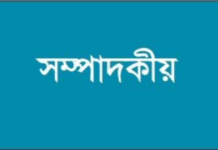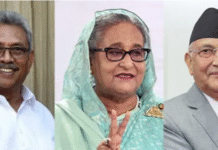The recently published Water Act 2013 is based on the National Water Policy, and designed for integrated development, management, extraction, distribution, usage, protection and conservation of water resources in Bangladesh. In general, if one takes a critical look at the Act, the new law has provided the right framework for better management of water resources in the country.
The formation of the high-powered National Water Resources Council (henceforth termed as the Council) with the prime minister as the head implies the importance the government is paying to the management of this precious resource. An Executive Committee under the Ministry of Water Resources will implement the decisions taken by the Council. The intention to take initiatives for a basin-scale, integrated water resources management of trans-boundary rivers, and exchange of data on flooding, drought, and pollution with co-riparian countries are good steps in the right direction.
As per this Act, all forms of water (e.g., surface water, ground water, sea water, rain water and atmospheric water) within the territory of Bangladesh belong to the government on behalf of the people. The private landowners will be able to use the surface water inside their property for all purposes in accordance with the Act. A worthwhile initiative is the requirement for permits/licenses for large scale water withdrawal by individuals and organizations beyond domestic use. Without prior permission issued by the Executive Committee, no individuals or organizations will be allowed to extract, distribute, use, develop, protect, and conserve water resources, nor they will be allowed to build any structure that impede the natural flow of rivers and creeks. However, the maximum amount of surface water or groundwater that can be withdrawn by individuals or organizations is not mentioned in the Act. Setting up a priority order for water usage in an area where the water resources is in critical condition is also a significant step. The priority order as depicted in the Act is as follows: drinking water>domestic usage>irrigation>fish culture> bio-diversity>wildlife>instream flow>industry>salinity control>power generation>recreation>miscellaneous. It should be noted that only drinking water and domestic usage are considered as basic rights.
In view of water resources protection and conservation, the Act adopted a timely decision to address the water needs in irrigation and urban areas in the context of available surface water, groundwater, and rainwater. The situation of drinking water supply in Dhaka City is a good example in this context. For instance, Dhaka City annually receives about 2000 mm of precipitation, of which about 80% occurs during the rainy season. If the rainwater is harvested and distributed after proper treatment then the water needs during this time period can easily be met.
The need for water resources management in the context of natural drainage pattern has also been correctly highlighted in the Act. Management of water resources within the territory of the country in rivers, creeks, reservoirs, flood flow zone, and wetlands has been assigned to the Executive Committee under the Ministry of Water Resources, which is another noteworthy decision. Draining of wetlands that support migratory birds has been prohibited by the Act. Consequently, without prior permission from the Executive Committee, building of any structure that can impede the natural flow of water has been prohibited; however a few activities, including dredging of rivers for maintaining navigability, land reclamation projects by filling wetlands, flood control and erosion control structures will be exempted pending prior permission. It is not clear as to how or if the government will address the issue of land grabbing and encroachment that are clear impediment to natural flow in the flood flow zone, wetlands, and foreshore of rivers.
Public hearing for the proposed national water management plan is also a good decision, provided it is practiced diligently. There have been occasions in which the opinion and interest of the stakeholders were ignored, which led to failure of such projects. The case of Korum River sluice gates project in Panchgarh Upazilla is a point of interest. This project was undertaken at a cost of Tk. 78 lacs to retain water for irrigation during dry season, which failed the same year it was constructed (The Daily Prothom Alo, 23 June 2012).
The Act provides provisions for punishment and financial penalty for non-compliance with the Act, including negligence to abide by government policy, ordinance, non-cooperation with government officials, refusal to present necessary documents, providing false information, affiliation with perpetrators, and protection measures for water resources management. The maximum penalty for violations is set to five years of imprisonment and/or monetary penalty of Tk.10, 000. The amount of monetary penalty was set to be Tk. 500,000 in the draft proposal of the Act in 2012. This drastic reduction in monetary penalty may encourage many people to pay the penalty instead of abiding by the law. Punishment related to water quality degradation caused by industrial discharge and other sources of pollution is not adequately addressed in the Act. Water pollution issues are deferred to the provisions of the Environmental Protection Act of 1995 without much clarification. The Act remains nebulous without a clear commitment by the government to ensure the quality of water for various beneficial uses as outlined in the Environmental Protection Act. The Act does not address the need for establishing effluent treatment plants or the maximum contaminant levels that will be allowed for discharge to receiving bodies of water by industries and other potential sources of pollution. Since the Act outlines various punishable activities, it is expected that provisions for punishment and penalty for water quality degradation be included in future amendments.
No court can accept any law suit under the provision of this Act without a written complaint from the Director General of Water Resources Planning Organization or his appointee, which is a severe drawback of this Act. Although the Act is formulated to protect the quality and quantity of the water resources that belong to the people, no individual or organization will be allowed to file a law suit against other individuals, organizations, or government authority if even they violate various provisions of the Act. The Act provides unlimited power to the Executive Committee to take any action that they deem necessary to implement various provisions of the Act. This Act also exempts the government authority of any violation, non-compliance, negligence, wrongfully causing financial damage to individuals or organizations, and/or avoidance to implement this Act in the name of good faith. Limitless power of the Executive Committee without any provision for check against such power may lead to wrong-doing and anarchy. Although an accused will be allowed to defend oneself in the court, there is no clear provision to appeal against any judgment given out by a court.
In summary, the Act recognizes the significance for managing all forms of water resources in the context of natural flow of surface water and recharge of groundwater. The Act provides the legal framework for development, management, extraction, distribution, usage, protection, and conservation of water resources. However, the Act falls short in making a commitment by the government to ensure the quality of water for various beneficial uses. The lack of clear directives that will facilitate recovery of the flood flow zone by evicting land grabbers and encroachers remains as a serious weakness of the Act. The unlimited power vested upon the Executive Committee without any liability has the potential for misuse of the Act. The people – the ultimate owner of water resources – should be empowered to file complaints and law suits against other individuals, including the government agencies, who are in non-compliance with the Act. Hopefully, future amendments will address the drawbacks in the Act to make it a useful tool for better management of the water resources.
Source: bdnews24











Review of water Act 2013 should be widely circulated in the country’s every knock and corner for information and necessary action by all people. It is important to realize that without understanding and participation of the mass people, the management of water sourcing both domestic and international cannot be made successful. The identity of the members of the high powered national water resources council and also the identity of members of executive committee under the council should be published for general information.